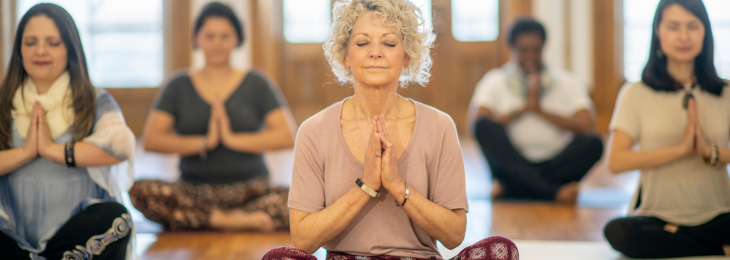Exercise offers many benefits to your overall health, including improved circulation, heart function, stress reduction, metabolism, and mood. But when you have glaucoma, you may worry that certain exercises could raise your eye pressure (IOP) or otherwise harm your optic nerve. The good news is that many forms of physical activity are safe and may even help support eye health when done carefully.
Discover how exercise and IOP interact, what kinds of activities tend to be safer or riskier, how to adapt routines to protect your vision, and how to build a sustainable exercise plan that supports your glaucoma management.*
Why Exercise Matters, and What It Does to IOP
- Benefits tied to glaucoma outcomes: Regular physical activity has been associated with slower visual field loss in people with glaucoma. One review noted that aerobic and resistance training both produce transient reductions in IOP after exercise.
- Mechanisms of benefit: Exercise may improve ocular blood flow, reduce vascular stress, and support neuroprotection of retinal ganglion cells. In people who are more sedentary, the IOP‐lowering effects after exercise may be more pronounced.
- Caution about generalization: While the short‐term drops in IOP are promising, long-term randomized trials in glaucoma patients are still scarce. So, the goal is not to rely solely on exercise to control glaucoma, but to use it as a complementary strategy.

Safe Exercise Types & Adaptations
Here are exercise modes generally considered safer (with caveats) when managing glaucoma:
- Aerobic (cardio) exercise
- Walking, cycling (on level ground), swimming, and low‐impact treadmill work are good options. Many guidelines recommend 30 minutes of moderate activity most days.
- In glaucoma patients, dynamic exercise such as jogging or cycling has been shown to reduce IOP, especially with longer or more intense intervals.
- Low to moderate resistance training
- Use lighter weights, controlled movements, and more repetitions. Avoid heavy lifting or straining.
- Always avoid the Valsalva maneuver (holding your breath or straining), which can spike venous and ocular pressure.
- Be particularly careful when lifting above your head or doing exercises with your head lower than your heart (e.g., decline bench press).
- Yoga, stretching & mind-body movement
- Avoid inverted poses (like headstands, downward dog with head lower than heart, plow pose) because they are known to cause acute IOP increases.
- Choose more neutral poses (standing, seated stretches, gentle twists), ensuring head remains above heart.
- Breathing, relaxation, and stress reduction components (e.g., slow breathing) may even help lower IOP modestly over time.

What to Avoid or Use with Caution
- Heavy weightlifting, maximal lifts, or isometrics: Exercises that involve holding a position under strain (planks, heavy squats, deadlifts) may cause transient but high increases in IOP, especially if breath is held.
- Inverted postures or head-below-heart positions: As above, some yoga or gym maneuvers (headstands, inversion tables, deep forward folds) should be avoided or modified.
- Tight goggles or face pressure: When swimming, goggles that press directly on the orbital tissues can slightly raise IOP. Use goggles that distribute pressure on the cheekbones and brow instead of the eyelids.
- Sudden bursts of maximal effort or holding breath: High-intensity bursts, especially combined with breath holding, may cause IOP spikes. Use gradual ramping in intensity, and always breathe out during exertion.
How to Build a Glaucoma-Safe Exercise Routine
- Begin gently and progress gradually
Start with light to moderate aerobic exercise (e.g., brisk walking 10–15 minutes). Monitor how your eyes feel and adapt as tolerated.
- Schedule around your eye drops and testing
If possible, exercise at times when IOP is more stable (discuss timing with your eye doctor). Avoid immediately prior to clinic visits so that you don’t artificially influence test IOPs.
- Incorporate variety
Combine aerobic work, gentle resistance (with light weights or resistance bands), flexibility, and mind-body practices like yoga or Tai Chi (modified). Variety helps maintain adherence and works different systems.
- Watch breathing and posture
Always exhale during exertion; never hold breath. Keep head and torso above the level of heart when possible. Avoid bending or positions where your eyes are lower than your heart.
- Track symptoms and relate to ophthalmic data
If you experience eye pain, headaches, blurring, or unusual symptoms during or after exercise, pause and report to your eye doctor. Over time, compare your visual field or OCT results with your routine to see if there is any relationship.
- Consult your care team and get clearance
Before starting or changing an exercise routine, check with your ophthalmologist, primary care provider, or physiotherapist—especially if you have other health issues (e.g., hypertension, cardiovascular disease, joint problems).
Bottomline
You don’t have to give up exercise because of glaucoma. In fact, a vision-safe, tailored exercise routine can benefit your overall health and may support your eye health as a complementary strategy. Stick to moderate aerobic activities, use light resistance, avoid inverted or high-strain positions, control your breathing, and progress gradually. Always monitor how your eyes respond, and coordinate with your eye care provider so your exercise supports, not undermines, your glaucoma management.
Sources
- BrightFocus Foundation. Diet, Exercise, and Other Habits That May Help Reduce Glaucoma Risk (2024). brightfocus.org
- Frontiers in Physiology. Acute Effects of Exercise on Intraocular Pressure in Patients with Primary Open-Angle Glaucoma (2024). frontiersin.org
- MDPI Applied Sciences. The Role of Exercise in the Management of Glaucoma: Evidence and Perspectives (2025). mdpi.com
- COSPRC (Canadian Ophthalmological Society). Lifestyle Habits in Glaucoma: Practical Advice for Patients and Ophthalmologists (2023). cosprc.ca
- PMC. Aerobic and Resistance Exercise in Glaucoma Patients: Impact on IOP and Visual Field Progression (2023). pmc.ncbi.nlm.nih.gov
To ensure that we always provide you with high-quality, reliable information, The Glaucoma Community closely vets all sources. We do not, however, endorse or recommend any specific providers, treatments, or products, and the use of a given source does not imply an endorsement of any provider, treatment, medication, procedure, or device discussed within.




Add Comments
Cancel